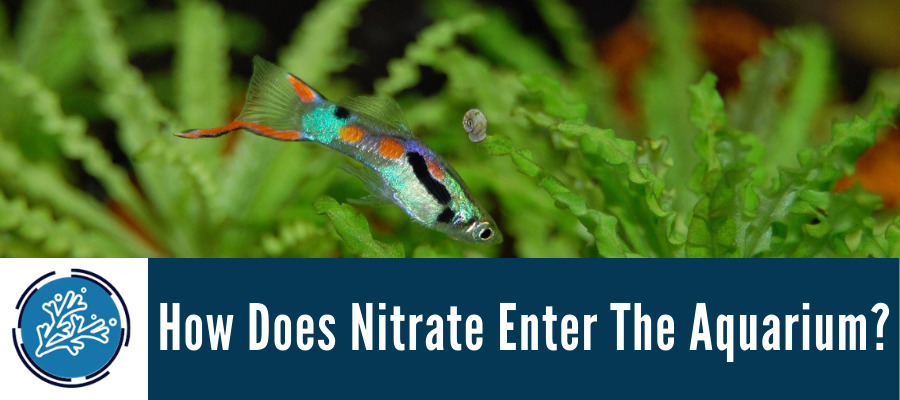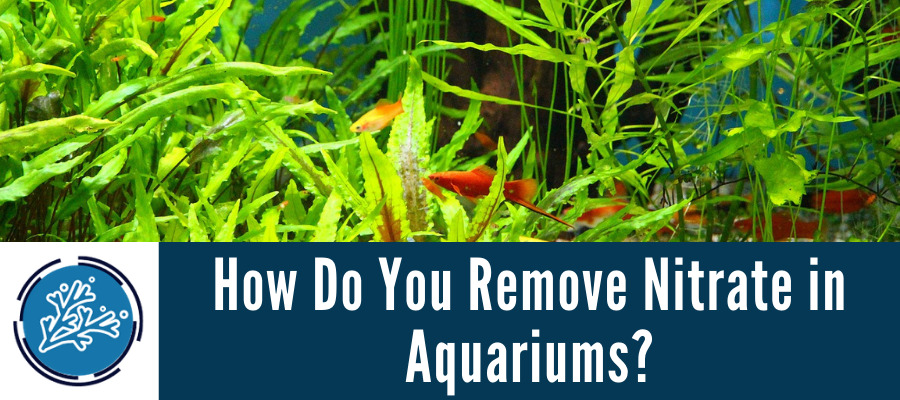Last Updated on February 10, 2023 by Matt
Nitrate in aquariums is less understood by the vast majority of aquarists, so don’t worry if you are one of them!
Nitrate is a bit of an awkward compound in aquariums. On one hand it is an important fertilizer and is needed by plants to remain healthy. But on the other if the concentrations get too high it can be very toxic to fish, causing nitrate poisoning, and can cause algal blooms in the tank.
In this article hopefully you will gain knowledge on what nitrate is, how it is put into the water column, and what you can do to reduce the nitrate levels.
IN THIS ARTICLE
What is Nitrate?
Nitrate has the chemical formula NO3–. It provides an important supply of nitrogen for plants; plants use nitrates to produce proteins for growth and to remain healthy. Nitrate is often found in aquarium plant fertilizer.
Without enough nitrates the amount of chlorophyll in the leaves reduces. In case you don’t remember your school biology, chlorophyll is the green photosynthetic pigment found in plants, algae, and cyanobacteria. Chlorophyll is the site of photosynthesis, which is vital to plants’ survival, as it produces energy from sunlight.
How Does Nitrate Enter The Aquarium?

Nitrate enters the aquarium water column through the natural processes involved in the aquarium nitrogen cycle.
As fish feces, leftover food, and dead plant matter decomposes in the tank, ammonia is produced by the bacteria feeding on this decaying matter. This process is called mineralization.
Another process, nitrification, is undertaken by other bacteria. These nitrifying bacteria convert the ammonia produced during mineralization to nitrite, and then convert this to nitrate.
These nitrifying bacteria can colonize the aquarium substrate and mechanical filter, but the main place they will colonize is the biological filter. Nitrate can also be found in tap water, but is removed in RODI water systems.
What is a Healthy Level of Nitrate in Aquariums?
Nitrate in aquariums should ideally be kept below 25 parts per million (ppm). In freshwater aquariums if you have a nitrate level of higher than 50 ppm then you have a problem and should conduct a water change soon.
If your aquarium has an algal problem and you are trying to get rid of it, then you need to ensure that the nitrate level is as low as possible. It needs to be below 10 ppm to starve the algae of the source of nitrogen they need to thrive.
If you are trying to encourage breeding in your aquarium fish then you should also keep the nitrate level to below 10 ppm, as fry are more susceptible to nitrate poisoning.
How Do You Remove Nitrate in Aquariums?

Nitrate is an important source of nitrogen for aquarium plants. Therefore the live plants you have in the tank will remove nitrate from the water column. So putting more aquarium plants in your tank will help to remove any excess nitrate that is building up.
Nitrate will also be removed by bacteria found in the biological filter, in a process called denitrification. This process is a natural part of the aquarium nitrogen cycle. You can enhance denitrification by using very porous biological media in the filter. Very porous media will have an extremely large surface area for bacterial colonization, and will also promote anoxic conditions, which is needed for denitrification.
Water changes are a great way of removing excess nitrate from the water column. This is why regular water changes are an essential part of aquarium maintenance. Water changes will also remove ammonia and nitrite from the aquarium as well. Water changes can be made easier using a product like the Python water changer.
Why is it Important to Remove Nitrate From Aquariums?
Whilst nitrate isn’t toxic to fish in low concentrations, if left to build up to higher levels nitrate can cause great stress to your fish. This can directly cause health issues, as it makes them a lot more susceptible to disease.
Young fish and fry are a lot less resilient than adult fish to high nitrate concentrations in the tank. Their growth rates and development can be negatively affected. Nitrate can have an effect on the red blood cells that carry oxygen.
High levels of nitrate can also cause algae to become a huge problem in your tank. We have said that nitrate is important as a source of nitrogen for plants. The same is true of algae. If the levels of nitrate in aquariums are high, then algae will happily use the extra nutrients and bloom.
Algal blooms can be very harmful indeed in aquariums. Not only will free-floating algae proliferate in the water column and cloud the water, but algae will grow on the glass, plants, and decorations as well. All this extra algae will also cause the depletion of oxygen in the tank.
You might be thinking that algae are essentially plants, so don’t they produce oxygen during photosynthesis? And you would be right, they do. The problem lies in when all this extra algae dies. As the algae dies and decomposes, the bacteria which feed on this matter use oxygen, and a lot of it. So much so that the fish in the tank can be really negatively impacted. At worst they will suffocate from the lack of oxygen.
Conclusion
Whilst nitrate is a natural part of the nitrogen cycle and plays an important role as a fertilizer, it can also cause some real problems in the tank.
Ensure that nitrate in aquariums is kept at a healthy concentration, ideally 25 ppm or under.
To remove nitrate from fish tanks you can ensure that the biological filter is functioning properly, or install one, and conduct regular water changes.








